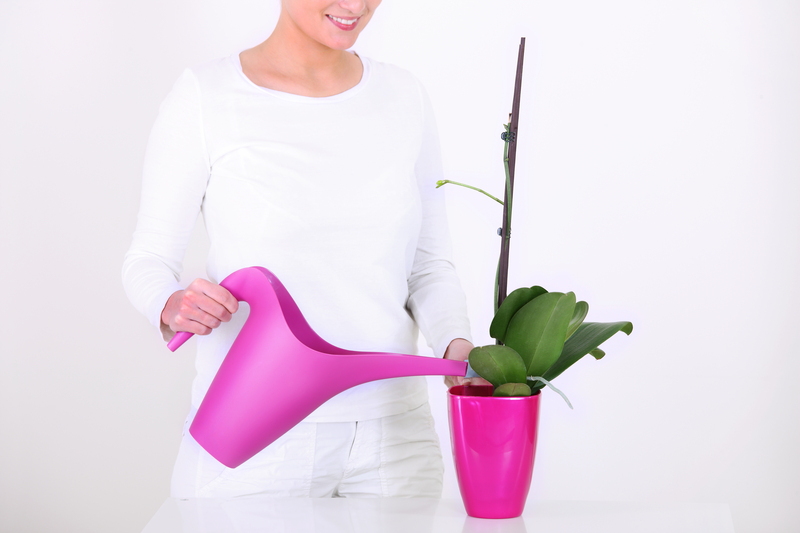The Art of Vertical Gardening
Posted on 01/07/2025
The Art of Vertical Gardening: Transforming Spaces with Greenery
Vertical gardening is more than just a trend--it's an innovative way to infuse life into urban environments, conserve space, and enhance aesthetics. This comprehensive guide explores every facet of cultivating a lush vertical garden, from concept to maintenance. If you're seeking tips, ideas, and the benefits of vertical gardening, you've come to the right place.

What Is Vertical Gardening?
Vertical gardening involves growing plants upward on a vertically suspended frame rather than spreading them horizontally on the ground. This style of gardening is especially popular in cities, where space is limited, and creativity is essential.
- Vertical planting systems use walls, fences, trellises, hanging pots, and specialized green walls.
- Allows for the cultivation of ornamental, edible, and air-purifying plants.
- Creates stunning living visuals in both indoor and outdoor environments.
Why Choose Vertical Gardening?
With urbanization on the rise, the art of vertical gardening provides a solution to limited garden spaces, poor air quality, and bland cityscapes. Here's why it's worth considering:
- Saves space: Ideal for apartments, balconies, and small yards.
- Improves air quality: Plants filter pollutants and increase oxygen.
- Enhances aesthetics: Vertical gardens create beautiful living walls.
- Reduces urban heat: Greenery decreases wall surface temperatures and helps regulate internal building climate.
- Boosts mental well-being: Interacting with plants has proven psychological benefits.
Types of Vertical Gardens
The beauty of vertical landscaping is in its versatility. There are several styles and techniques for aspiring gardeners, each serving different spaces and needs.
Living Walls
Also known as green walls or plant walls, these systems use modular panels packed with soil or hydroponic setups. They're commonly seen in corporate lobbies, homes, and public spaces, acting as both art and functional greenery.
- Built-in irrigation systems simplify maintenance.
- Can be customized with a range of plant species.
- Excellent for large indoor or outdoor spaces.
Pocket and Container Gardens
For beginners in vertical gardening, pocket planters or hanging pots provide a flexible entry point. These setups include fabric pockets, wall-mounted pots, or DIY containers attached to a trellis or wooden pallet.
- Easy to relocate or expand as needed.
- Ideal for herbs, small edibles, and flowers.
- Perfect for balconies and patios.
Trellises and Climbing Supports
Traditional vertical gardens rely on trellises, arbors, and lattices for supporting climbing plants like beans, peas, and flowering vines.
- Simple installations made from wood, plastic, or metal.
- Encourages natural plant growth up walls or fences.
- Adds privacy or divides spaces with a living screen.
Design Principles for Vertical Gardens
Creating a visually pleasing, thriving vertical garden requires thoughtful planning. Implement these principles when designing your living wall garden:
1. Assess Space and Light
Different plants thrive in different lighting. Observe your chosen spot--does it get full sun, partial shade, or is it indoors? Select plants based on natural light, wall orientation, and exposure to wind or rain.
2. Structure and Support
The success of vertical planting systems relies on a sturdy support. Materials must withstand the weight of soil, plants, and moisture:
- Metal grids for heavy-duty installations
- Wooden frames for rustic charm
- Recycled pallets for eco-friendly projects
3. Plant Selection
Choose varieties suited to your environment and level of care. For indoor green walls:
- Pothos
- Spider plants
- Peace lilies
- Fern species
For outdoor living walls:
- Succulents
- Ornamental grasses
- Creeping figs
- Herbs like mint, basil, or thyme
4. Watering and Drainage
Efficient irrigation prevents root rot and supports healthy growth. Options include:
- Drip irrigation systems for automated watering
- Integrated reservoirs for hydroponic walls
- Manual watering for small containers or pockets
Good drainage is essential--ensure excess water escapes to avoid pooling.
DIY Vertical Gardening: Step-by-Step Guide
Interested in creating your own vertical garden? Here's a straightforward process for beginners:
Step 1: Choose the Location
- Pick a spot with proper sunlight and shelter from strong winds.
- Measure the available space on your wall or fence.
Step 2: Select Your Vertical Gardening System
- Pocket fabric systems for ease and flexibility
- Wall-mounted pots and planters
- Pallet-based gardens for an upcycled look
- Trellises for climbing plants
Step 3: Gather Materials
Common supplies include:
- Pots, planters, or modular wall panels
- Quality potting mix and compost
- Chosen plants or seeds
- Watering cans or drip irrigation kits
- Screws, hooks, or other mounting hardware
Step 4: Assemble and Plant
- Secure your framework or containers to the wall.
- Add potting mix and arrange plants from largest (at the bottom) to smallest (top) for balanced growth and watering.
- Water thoroughly and place in sunlight as required.
Step 5: Maintain and Enjoy
- Regularly check soil moisture--vertical gardens dry out faster than beds.
- Fertilize every few weeks for lush growth.
- Prune and replant as needed to keep your living wall healthy and attractive.
Best Plants for Vertical Gardens
Not all plants are suitable for vertical or wall-based gardening. Here are some resilient and low-maintenance vertical garden plants favored by seasoned gardeners:
Ornamental Favorites
- English Ivy (Hedera helix): Elegant, evergreen, and great for air quality.
- Golden Pothos (Epipremnum aureum): Hardy and attractive trailing foliage.
- Boston Fern: Adds lush texture and thrives in shade.
- Wax Begonia: Colorful and low-care.
Edible Options
- Herbs: Basil, chives, thyme, and parsley thrive in small pockets.
- Strawberries: Yield well and look beautiful in vertical planters.
- Leafy greens: Lettuce, spinach, and arugula grow quickly and vertically.
Flowering Climbing Plants
- Clematis: Gorgeous blooms throughout the season.
- Morning glory and sweet pea: Fast climbers for trellises.
- Jasmine: Adds fragrance and white flowers.
Succulents for Low Maintenance
- Hens-and-Chicks (Sempervivum): Require little water and minimal attention.
- Sedum: Ideal for bright, dry walls.
- Aloe Vera: Medicinal and attractive.
Care and Maintenance of Vertical Gardens
Maintaining a vibrant, thriving vertical garden wall requires a little effort and attention:
- Regular Watering: Especially critical for wall planters which lose moisture more rapidly. Drip irrigation helps automate the process.
- Pruning and Cleaning: Trim dead or dying foliage, and keep leaves clean to encourage healthy growth.
- Nutrition: Supplement soil with organic fertilizers every few weeks. Hydroponic systems may need added nutrients more frequently.
- Pest Management: Monitor for common pests like aphids or spider mites, and treat with organic insecticidal soap when necessary.
- Replanting: Some annuals or edible plants need refreshing every season for continuous beauty and productivity.
The Environmental Benefits of Vertical Gardening
Beyond aesthetics and space savings, vertical garden designs are a boon for the planet. The key positive impacts include:
- Combating urban heat: Plant-covered surfaces reflect less heat and keep buildings cooler.
- Improved air quality: More plants mean greater air filtration and oxygen production.
- Supporting pollinators: Flowering vertical gardens support bees, butterflies, and birds in cities.
- Reducing noise pollution: Dense plantings absorb and muffle sound in busy environments.
- Enhancing biodiversity: Offers mini-habitats for a variety of insects and small creatures.
Inspirational Ideas for Your Vertical Garden
Ready to unleash your creativity? Consider these stunning ideas for vertical gardening projects:
- DIY pallet gardens for rustic backyard walls.
- Herb spirals or stacked pots for fresh cooking ingredients in the kitchen.
- Sculptural green walls using modular systems in entryways or patios.
- Living privacy screens made from trellised vines on balconies.
- Colorful succulent mosaics in wall-mounted frames for low-water needs.
Expert Tip:
Mix and match leaf textures, colors, and plant heights to ensure visual interest and year-round appeal.

Challenges and Solutions in Vertical Gardening
Like any gardening endeavor, vertical gardens come with unique challenges--fortunately, they're easy to overcome:
- Issue: Uneven watering can cause top plants to dry out faster than those below.
Solution: Install a drip irrigation system or water more frequently, focusing on upper rows. - Issue: Poor structural support can lead to wall or plant damage.
Solution: Use secure fixing methods and check weight limits before installation. - Issue: Sunscald or excessive shade can weaken plants.
Solution: Position the garden based on plant light needs, and choose species accordingly.
Conclusion: The Endless Possibilities of Vertical Gardens
The art of vertical gardening is a transformative, sustainable approach to modern landscape design. Whether in a modest apartment or a sprawling outdoor space, vertical gardens offer an irresistible blend of beauty, functionality, and environmental stewardship. With a thoughtful plan and a dash of creativity, anyone can master this lush, life-enhancing art form.
If you're ready to elevate your greenery--literally--start exploring the endless vertical gardening possibilities today. Not only will you beautify your space, but you'll also make a positive impact on your well-being and the world around you.



